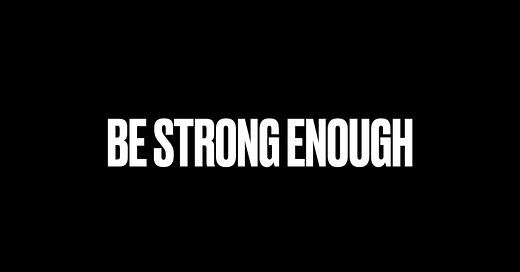Post summary:
Chasing strength for the sake of it can backfire.
It’s likely better for your time and long-term health and performance to be “strong enough.”
We’ll explain what “strong enough” is and how to reach it safely and in a way that gives you better performance and health.
Then we’ll highlight a fantastic leg exercise that gets you “strong enough.”
Housekeeping
Full access to this post, like all Wednesday and Friday posts, is for Members of Two Percent. Become a Member below.
Or follow this link for seven free days of Two Percent. We partnered with Substack to give you a free weeklong Membership through the app.
We have a great book discussion going on in the Two Percent Chat. The question: What are you currently reading? Tell us about the book and if you recommend it. Don’t cheat! You have to be currently reading the book. Weigh in here.
Thanks to our partners, who make the best products in their categories:
GOREWEAR: Maker of cutting-edge, science-backed endurance apparel that performs no matter what nature throws at you. Their gear has the official “Have Fun, Don’t Die” seal of approval. Check out the Concurve Jacket.
Momentous Nutrition: The company that made me feel good about supplements again. My picks: Essential Plant Protein + Multivitamin.
GORUCK: Maker of the best rucking gear (not stuff). My picks: Rucker 4.0 for rucking and GR1 for travel.
Use discount code EASTER30 for 30% off of GOREWEAR and EASTER for a discount at Momentous and GORUCK.
Audio/podcast version
The post
Years ago, I decided to get really strong in the deadlift.
It’s an important exercise—the deadlift is an act of picking something up off the ground. Few movements are more useful than that.
The thinking among some people was the stronger in the deadlift you got, the better off you’d be.
So I went for it. I started deadlifting all the time, piling weight on the bar, and training hard.
But soon I noticed some downsides of getting really strong for the sake of it.
My endurance started falling off. My hips and knees began hurting after my Sunday trail runs.
My gym sessions also suffered. If I wanted to deadlift properly and do all the “other stuff” that would make me healthier overall, I’d be in the garage gym longer than I wanted. Or I’d have to cut my workouts short and miss out on all that important “other stuff” to fit in all the deadlifting.
We often think it’s best to be as strong as possible.
That might be true in a vacuum, but life isn’t a vacuum1. Piling on strength for the sake of it:
Can be a bad return on your limited time because it takes away from other health and fitness-enhancing skills.
Often makes you worse in other important fitness qualities, degrading your overall fitness.
Can increase your likelihood of getting injured, which can impact your ability to exercise over the long haul (leading to a whole host of downstream problems).
I’ve found it far more useful to be strong enough.
That is to say, strong enough to do the job well—whatever that job may be—and avoid injury along the way.
When I’m strong enough, I can cover more ground outside, power up hills faster, do physical labor well, and just generally live better.
In other words, I’m capable and well-rounded. I’m SUPERMEDIUM.
Choose your exercises well
After my experience with the deadlift, I started thinking more about exercise selection.
Certain exercises seem to be better at getting us strong in a way that translates to our larger goals. They get us strong safely, build general athleticism that translates to life and the outdoors, and give us clear markers when we’re strong enough.
In other words, we’re good to go once we can lift a certain amount of weight in these exercises.
With that in mind, here’s a leg exercise I’ve been doing for the past few months.
It’s safe.
It’s effective.
It gives me a clear marker when my lower body is strong enough.
Once you can use a certain amount of weight in this exercise (as a percentage of your bodyweight), your lower body is probably strong enough.
I learned it from a legend in fitness. He works with people ranging from championship-winning pro athletes to busy workers who want to get healthier or perform better and avoid injury in hobbies ranging from ultra-running to golf and tennis.











